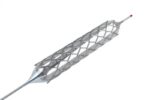Original title: Impact of coronary artery disease on left ventricular ejection fraction recovery following transcatheter aortic valve implantation. Reference: Freixa X et al. Catheter Cardiovasc Interv. 2014;Epub ahead of print. This single center study analyzed data form 56 consecutive patients with severe aortic stenosis and LVEF of ≤ 50% undergoing TAVI (transcatheter aortic valve implantation) between March 2006<a href="https://solaci.org/en/2014/10/06/n-4740/" title="Read more" >...</a>
Resistance to Aspirin Associated to Greater Risk of In-Stent Thrombosis and Death
Original title: Aspirin Treatment and Outcomes After Percutaneous Coronary InterventionResults of the ISAR-ASPI Registry. Reference: Katharina Mayer et al. J Am CollCardiol. 2014;64(9):863-871. Aspirin administration, as part of the double antiagregation scheme, is essential in the context of PCI. The correlation between high platelet reactivity to on-clopidogrel treatment and higher events rates has been well established, while data<a href="https://solaci.org/en/2014/08/29/n-4705/" title="Read more" >...</a>
Less Bleeding at the Expense of a Higher Risk of Acute Thrombosis with Bivalirudin
Original title: Bivalirudin versus heparin in patients treated with percutaneous coronary Intervention: a meta-analysis of randomised trials. Reference: Salvatore Cassese et al. EuroIntervention 2014;10-online publish-ahead-of-print August 2014. Current recommendations for the use of bivalirudin in PCI patients are mostly based on studies comparing bivalirudin vs. heparin combined with glycoprotein IIb/IIIa inhibitors. Whether bivalirudin is superior to heparin alone<a href="https://solaci.org/en/2014/08/20/n-4677/" title="Read more" >...</a>
Percutaneous Coronary Intervention to Unprotected Left Main Stem In Different Coronary Syndromes
Original title: Comparative Outcomes After Unprotected Left Main Stem Percutaneous Coronary Intervention: A National Linked Cohort Study of 5,065 Acute and Elective Cases From the BCIS Registry (British Cardiovascular Intervention Society). Reference: Sami S. Almudarra, et al. JACC Cardiovasc Interv 2014;7:717-30 Although myocardial revascularization surgery has long been the gold standard treatment for left main lesions, PCI has<a href="https://solaci.org/en/2014/08/13/n-4663/" title="Read more" >...</a>
Reduced risk of acute, late and very late thrombosis with new generations of DES versus BMS in the acute myocardial context
Original title: Stent thrombosis in new-generation drug-eluting stents in patients with STEMI undergoing primary PCI: a report from SCAAR. Reference: Sarno G et al. J Am Coll Cardiol. 2014;Epub ahead of print. This study evaluated 34147 consecutive patients suffering acute myocardial infarction with ST-segment elevation included in the SCAAR registry (Swedish Coronary Angiography and Angioplasty Registry) undergoing primary<a href="https://solaci.org/en/2014/07/11/n-4593/" title="Read more" >...</a>
Elevated C-reactive protein levels could predict future events associated to non-culprit lesions. PROSPECT study sub analysis.
Original title: Relation of C-reactive protein levels to instability of untreated vulnerable coronary plaques (from the PROSPECT study). Reference: Kelly CR et al. Am J Cardiol. 2014;Epub ahead of print. The original PROSPECT study included 697 patients with acute coronary syndrome (ACS) undergoing culprit artery percutaneous coronary intervention (PCI) followed by intravascular ultrasound (IVUS) to the rest of<a href="https://solaci.org/en/2014/06/09/n-4509/" title="Read more" >...</a>
The radial access is a viable alternative in infarction complicated with cardiogenic shock
Original title: Arterial access site utilization in cardiogenic shock in the United Kingdom: Is radial access feasible? Reference: Mamas A. Mamas, et al. Am Heart J 2014;167:900-08 Cardiogenic shock in the context of acute myocardial infarction is associated with high mortality, and represents approximately 10% of major bleeding complications. Radial Access reduces mortality mainly by reducing bleeding; however,<a href="https://solaci.org/en/2014/06/05/n-4502/" title="Read more" >...</a>
Coronary Artery Bypass Grafting and Percutaneous Coronary Intervention show similar outcomes for ostial/midshaft lesion in Unprotected Left Main Coronary Artery
Original title: Long-Term Clinical Outcome Intervention Versus Coronary Artery Bypass Grafting for Ostial/Midshaft Lesion in Unprotected Left main Coronary Artery From The DELTA Registry. Reference: Toru Nagamuna et al. JACC Cardiovascular Intervention. Article in Press Even though surgery remains the “gold standard” to treat UMCLA lesions, current guidelines have incorporated PCI as class IIa at ostium/midshaft level. The<a href="https://solaci.org/en/2014/04/04/n-4383/" title="Read more" >...</a>
Los resultados del sistema Corevalve® de Medtronic son superiores a la cirugía a corazón abierto a un año en un estudio fundamental de EE.UU
-Estudio de Alto Riesgo de CoreValve: La FDA Determina que No se Requiere un Panel de Expertos-Baja Tasa de Mortalidad Supera las Expectativas para el Punto Final Primario-El Sistema CoreValve es la Primera y Única Válvula Aórtica Transcatéter que Presenta Resultados Superiores al Reemplazo Quirúrgico de la Válvula Aórtica MINNEAPOLIS y WASHINGTON – 29 de<a href="https://solaci.org/en/2014/03/29/n-4488/" title="Read more" >...</a>
Deferred Stenting in Primary Angioplasty could reduce No Reflow Risk and Infarct Size.
Original: A Randomized Trial of Deferred Stenting versus Immediate Stenting to Prevent No-or Slow Reflow in Acute ST-Elevation Myocardial Infarction (DEFER-STEMI). Reference: David Carrick et al. J Am Coll Cardiol. 2014. Epub ahead of print. No Reflow physiopathology involves microvascular obstruction secondary to thrombus embolization, spasm or microvascular thrombosis, and happens in approximately 10% of PCI procedures. The<a href="https://solaci.org/en/2014/03/17/n-4341/" title="Read more" >...</a>









